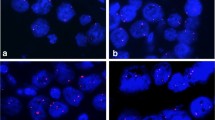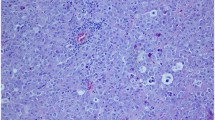Abstract
Testicular carcinoma in situ (CIS) is the precursor of germ cell tumours in adults, except for spermatocytic seminoma. The mechanism of the progression from premalignant CIS to invasive and overt tumours is largely unknown. There are currently two main hypotheses: one is that CIS can progress directly to either seminoma or nonseminoma; according to the other, seminoma is the intermediate stage between CIS and nonseminoma. CIS cells express several tumour antigens, such as placental-like alkaline phosphatase (PLAP), TRA-1-60, or the c-kit proto-oncogene protein product (Kit), which are present to varying degrees in the invasive germ cell tumours. In this study, CIS cells adjacent to either pure or combined tumours were examined by double immunohistochemical staining for simultaneous expression of TRA-1-60 (typical for embryonal carcinoma) and either Kit (expressed by seminomas) or PLAP (found mainly in seminomas, but also in some cases of nonseminoma). Marked differences in the expression of these antigens were found among CIS cells, especially those adjacent to mixed tumours. We conclude that CIS is a phenotypically heterogeneous lesion, and that the CIS cells, despite identical morphology and close spatial localization, may be in different stages of progression. The results lend support to the hypothesis that CIS can progress directly to both seminomatous and nonseminomatous tumours.
Similar content being viewed by others
References
Andrews PW, Banting GS, Damjanov I, Arnaud D, Avner P (1984) Three monoclonal antibodies defining distinct differentiation antigens associated with different high molecular weight polypeptides on the surface of human embryonal carcinoma cells. Hybridoma 3:347–361
Coffin CM, Ewing S, Dehner CP (1985) Frequency of intratubular germ cell neoplasia with invasive testicular germ cell tumors: histologic and immunocytochemical features. Arch Pathol Lab Med 109:555–559
Czaja J, Ulbright TM (1992) Evidence for the transformation of seminoma to yolk sac tumor, with histogenetic considerations. Am J Clin Pathol 97:468–477
Damjanov I (1989) Is seminoma a relative or a precursor of embryonal carcinoma? (Editorial). Lab Invest 60:1–3
Damjanov I (1991) Pathobiology of human germ cell neoplasia. Recent Results Cancer Res 123:1–16
Eble N (1994) Spermatocytic seminoma. Hum Pathol 25:1035–1042
Egan MJ, Crocker J (1992) Nucleolar organizer regions in pathology. Br J Cancer 65:1–7
Gillis AJ, Looijenga LH, Jong B de, Oosterhuis JW (1994) Clonality of combined testicular germ cell tumors of adults. Lab Invest 71:874–878
Giwercman A, Cantell L, Marks A (1991) Placental-like alkaline phosphatase as a marker of carcinoma-in-situ of the testis. Comparison with monoclonal antibodies M2A and 43–9F. APMIS 99:586–594
Giwercman A, Andrews PW, Jørgensen N, Müller J, Græm N, Skakkebæk NE (1993) Immunohistochemical expression of embryonal marker TRA-1–60 in carcinoma in situ and germ cell tumors of the testis. Cancer 72:1308–1314
Giwercman A, Lenz S, Skakkebæk NE (1993) Carcinoma in situ in atrophic testis: biopsy based on abnormal ultrasound pattern. Br J Urol 72:118–120
Graaf W de, Oosterhuis JW, Jong B de, Dam A, Putten WLJ van, Castedo SMMJ, Sleijfer DT, Schraffordt Koops H (1992) Ploidy of testicular carcinoma in situ. Lab Invest 66:166–168
Grégoire M, Schopperle WM, DeWolf CW (1995) Distinct glycoforms of a tumor specific glycoprotein, gp 200, in human testis and testicular tumors. J Urol 154:275–277
Grigor KM (1993) A new classification of germ cell tumours of the testis. Eur Urol 23:93–103
Gurp RJLM van, Oosterhuis JW, Kalscheuer V, Mariman ECM, Looijenga LHJ (1994) Human testicular germ cell tumours show biallelic expression of the H19 and IGF2 gene. J Natl Cancer Inst 86:1070–1077
Hofmann M-C, Jeltsch W, Brecher J, Walt H (1989) Alkaline phosphatase isozymes in human testicular germ cell tumors, their precancerous stage, and three related cell lines. Cancer Res 49:4696–4700
Jong B de, Oosterhuis JW, Castedo SMMJ, Vos AM, Meerman GJ te (1990) Pathogenesis of adult testicular germ cell tumors. A cytogenetic model. Cancer Genet Cytogenet 48:143–167
Jørgensen N, Rajpert-De Meyts E, Græm N, Müller J, Giwercman A, Skakkebæk NE (1995) Expression of immunohistochemical markers for testicular carcinoma in situ by normal human fetal germ cells. Lab Invest 72:223–231
Krag Jacobsen G, Nørgaard-Pedersen B (1984) Placental alkaline phosphatase in testicular germ cell tumours and in carcinoma-in-situ of the testis. APMIS 92:323–329
Looijenga LHJ (1994) Pathobiology of germ cell tumors of the adult testis; views and news. Doctoral thesis, Erasmus University Rotterdam
Looijenga LHJ, Gillis AJM, Putten WLJ van, Oosterhuis JW (1993) In situ numeric analysis of centromeric regions of chromosome 1, 12, 15 of seminomas, non-seminomatous germ cell tumors and carcinoma in situ of human testis. Lab Invest 68:211–219
Loy V, Dieckmann KP (1990) Carcinoma in situ of the testis: intratubular germ cell neoplasia or testicular intraepithelial neoplasia? Hum Pathol 21:457
Manivel JC, Jessurun J, Wick MR, Dehner LP (1987) Placental alkaline phosphatase immunoreactivity in testicular germ cell neoplasms. Am J Surg Pathol 11:21–29
Meng FJ, Giwercman A, Skakkebæk NE (1996) Quantification of argyrophylic nucleolar organizer region associated proteins (AgNORs) in the carcinoma-in-situ cell of the testis by computer-aided image analysis. J Pathol (Lond) (in press)
Müller J, Skakkebæk NE, Lundsteen C (1981) Aneuploidy as a marker for carcinoma-in-situ of the testis. Acta Pathol Microbiol Scand [A] 89:67–68
Müller J, Skakkebæk NE, Constance Parkinson M (1987) The spermatocytic seminoma: views on pathogenesis. Int J Androl 10:147–156
Nistal M, Codesal J, Paniagua R (1989) Carcinoma in situ of the testis in infertile men. A histological, immunocytochemical, and cytomorphometric study of DNA content. J Pathol (Lond) 159:205–210
Oliver RTD (1987) HLA phenotype and clinicopathological behaviour of germ cell tumours: possible evidence for clonal evolution from seminomas to nonseminomas. Int J Androl 10:85–93
Oosterhuis JW, Castedo SMMJ, Jong B de, Cornelisse CJ, Dam A, Sleijfer DT, Schraffordt Koops H (1989) Ploidy of subtypes of primary germ cell tumors of the testis. Pathogenetic and clinical relevance. Lab Invest 60:14–21
Oosterhuis JW, Gillis AJM, Putten WLJ van, Jong B de, Looijenga LHJ (1993) Interphase cytogenetics of carcinoma in situ of the testis. Eur Urol 23:16–22
Pierce GB Jr, Abell MA (1970) Embryonal carcinoma of testes. Pathol Annu 5:27–60
Pugh RCB (ed) (1976) Pathology of the testis. Blackwell, Oxford London Edinburgh
Raghavan D, Sullivan AL, Peckham MJ, Neville AM (1982) Elevated serum alpha-fetoprotein and seminoma: clinical evidence for a histologic continuum? Cancer 50:982–989
Rajpert-De Meyts E, Skakkebæk NE (1994) Expression of the c-kit protein product in carcinoma-in-situ and invasive testicular germ cell tumours. Int J Androl 17:85–92
Skakkebæk NE (1972) Possible carcinoma-in-situ of the testis. Lancet II:516–517
Skakkebæk NE, Berthelsen JG (1981) Carcinoma-in-situ of the testis and invasive growth of different types of germ cell tumours. A revised germ cell theory. Int J Androl 4 [Suppl]:26–34
Skakkebæk NE, Berthelsen JG, Giwercman A, Müller J (1987) Carcinoma-in-situ of the testis: possible origin from gonocytes and precursor of all types of germ cell tumours except spermatocytoma. Int J Androl 10:19–28
Srigley JR, Mackay B, Toth P, Ayala A (1988) The ultrastructure and histogenesis of male germ cell neoplasia with emphasis on seminoma with early carcinomatous features. Ultrastruct Pathol 12:67–86
Strohmeyer T, Peter S, Hartmann M, Munemitsu S, Ackermann R, Ullrich A, Slamon DJ (1991) Expression of the hst-1 and c-kit protooncogenes in human testicular germ cell tumors. Cancer Res 51:1811–1816
Treré D, Farabegoli F, Cancellieri A, Ceccarelli C, Eusebi V, Derenzini M (1991) AgNORs area in interphase nuclei of human tumours correlates with the proliferative activity evaluated by bromodeoxyuridine labelling and Ki-67 immunostaining. J Pathol (Lond) 165:53–59
Walt H, Arrenbrecht S, Delozier-Blanchet CD, Keller PJ, Nauer R, Hedinger CE (1986) A human testicular germ cell tumor with borderline histology between seminoma and embryonal carcinoma secreted beta-human chorionic gonadotropin and alpha-fetoprotein only as a xenograft. Cancer 58:139–146
Author information
Authors and Affiliations
Rights and permissions
About this article
Cite this article
Rajpert-De Meyts, E., Kvist, M. & Skakkebæk, N.E. Heterogeneity of expression of immunohistochemical tumour markers in testicular carcinoma in situ: pathogenetic relevance. Vichows Archiv A Pathol Anat 428, 133–139 (1996). https://doi.org/10.1007/BF00200655
Received:
Accepted:
Issue Date:
DOI: https://doi.org/10.1007/BF00200655




